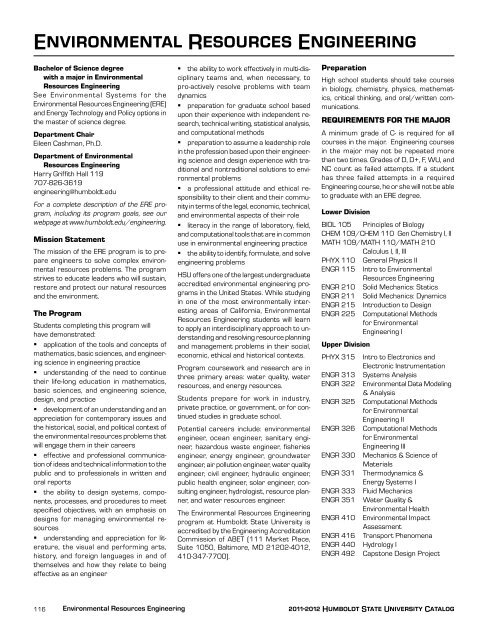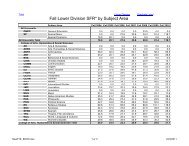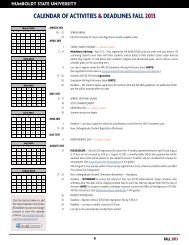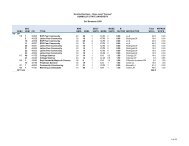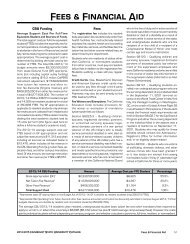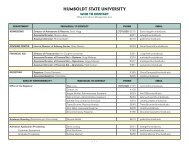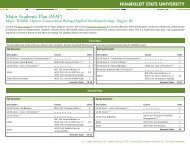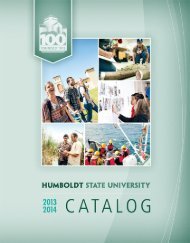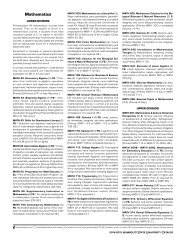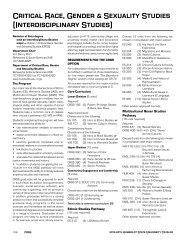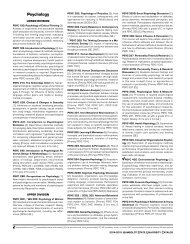2011-12 Academic Year - Bad Request - Humboldt State University
2011-12 Academic Year - Bad Request - Humboldt State University
2011-12 Academic Year - Bad Request - Humboldt State University
Create successful ePaper yourself
Turn your PDF publications into a flip-book with our unique Google optimized e-Paper software.
Environmental Resources Engineering<br />
Bachelor of Science degree<br />
with a major in En vi ronmental<br />
Resources Engineering<br />
See Environmental Systems for the<br />
Environmental Resources Engineering (ERE)<br />
and Energy Technology and Policy options in<br />
the master of science degree.<br />
Department Chair<br />
Eileen Cashman, Ph.D.<br />
Department of Environmental<br />
Resources Engineering<br />
Harry Griffith Hall 119<br />
707-826-3619<br />
engineering@humboldt.edu<br />
For a complete description of the ERE program,<br />
including its program goals, see our<br />
webpage at www.humboldt.edu/engineering.<br />
Mission <strong>State</strong>ment<br />
The mission of the ERE program is to prepare<br />
engineers to solve complex environmental<br />
resources problems. The program<br />
strives to educate leaders who will sustain,<br />
restore and protect our natural resources<br />
and the environment.<br />
The Program<br />
Students completing this program will<br />
have demonstrated:<br />
application of the tools and concepts of<br />
mathematics, basic sciences, and engineering<br />
science in engineering practice<br />
understanding of the need to continue<br />
their life-long education in mathematics,<br />
basic sciences, and engineering science,<br />
design, and practice<br />
development of an understanding and an<br />
appreciation for contemporary issues and<br />
the historical, social, and political context of<br />
the environmental resources problems that<br />
will engage them in their careers<br />
effective and professional communication<br />
of ideas and technical information to the<br />
public and to professionals in written and<br />
oral reports<br />
the ability to design systems, components,<br />
processes, and procedures to meet<br />
specified objectives, with an emphasis on<br />
designs for managing environmental resources<br />
understanding and appreciation for literature,<br />
the visual and performing arts,<br />
history, and foreign languages in and of<br />
themselves and how they relate to being<br />
effective as an engineer<br />
the ability to work effectively in multi-disciplinary<br />
teams and, when necessary, to<br />
pro-actively resolve problems with team<br />
dynamics<br />
preparation for graduate school based<br />
upon their experience with independent research,<br />
technical writing, statistical analysis,<br />
and computational methods<br />
preparation to assume a leadership role<br />
in the profession based upon their engineering<br />
science and design experience with traditional<br />
and nontraditional solutions to environmental<br />
problems<br />
a professional attitude and ethical responsibility<br />
to their client and their community<br />
in terms of the legal, economic, technical,<br />
and environmental aspects of their role<br />
literacy in the range of laboratory, field,<br />
and computational tools that are in common<br />
use in environmental engineering practice<br />
the ability to identify, formulate, and solve<br />
engineering problems<br />
HSU offers one of the largest undergraduate<br />
accredited environmental engineering programs<br />
in the United <strong>State</strong>s. While studying<br />
in one of the most environmentally interesting<br />
areas of California, Environmental<br />
Resources Engineering students will learn<br />
to apply an interdisciplinary approach to understanding<br />
and resolving resource planning<br />
and management problems in their social,<br />
economic, ethical and historical contexts.<br />
Program coursework and research are in<br />
three primary areas: water quality, water<br />
resources, and energy resources.<br />
Students prepare for work in industry,<br />
private practice, or government, or for continued<br />
studies in graduate school.<br />
Potential careers include: environmental<br />
engineer, ocean engineer, sanitary engineer,<br />
hazardous waste engineer, fisheries<br />
engineer, energy engineer, groundwater<br />
engineer, air pollution engineer, water quality<br />
engineer, civil engineer, hydrau lic engineer,<br />
public health engineer, solar engineer, consulting<br />
engineer, hydrologist, resource planner,<br />
and water resources engineer.<br />
The Environmental Resources Engineering<br />
program at <strong>Humboldt</strong> <strong>State</strong> <strong>University</strong> is<br />
accredited by the Engineering Accreditation<br />
Commission of ABET (111 Market Place,<br />
Suite 1050, Baltimore, MD 2<strong>12</strong>02-40<strong>12</strong>,<br />
410-347-7700).<br />
Preparation<br />
High school students should take courses<br />
in biology, chemistry, physics, mathematics,<br />
critical thinking, and oral/written communications.<br />
REQUIREMENTS FOR THE MAJOR<br />
A minimum grade of C- is required for all<br />
courses in the major. Engineering courses<br />
in the major may not be repeated more<br />
than two times. Grades of D, D+, F, WU, and<br />
NC count as failed attempts. If a student<br />
has three failed attempts in a required<br />
Engineering course, he or she will not be able<br />
to graduate with an ERE degree.<br />
Lower Division<br />
BIOL 105 Principles of Biology<br />
CHEM 109/CHEM 110 Gen Chemistry I, II<br />
MATH 109/MATH 110/MATH 210<br />
Calculus I, II, III<br />
PHYX 110 General Physics II<br />
ENGR 115 Intro to Environmental<br />
Resources Engineering<br />
ENGR 210 Solid Mechanics: Statics<br />
ENGR 211 Solid Mechanics: Dynamics<br />
ENGR 215 Introduction to Design<br />
ENGR 225 Computational Methods<br />
for Environmental<br />
Engineering I<br />
Upper Division<br />
PHYX 315 Intro to Electronics and<br />
Electronic Instrumentation<br />
ENGR 313 Systems Analysis<br />
ENGR 322 Environmental Data Modeling<br />
& Analysis<br />
ENGR 325 Computational Methods<br />
for Environmental<br />
Engineering II<br />
ENGR 326 Computational Methods<br />
for Environmental<br />
Engineering III<br />
ENGR 330 Mechanics & Science of<br />
Materials<br />
ENGR 331 Thermodynamics &<br />
Energy Systems I<br />
ENGR 333 Fluid Mechanics<br />
ENGR 351 Water Quality &<br />
Environmental Health<br />
ENGR 410 Environmental Impact<br />
Assessment<br />
ENGR 416 Transport Phenomena<br />
ENGR 440 Hydrology I<br />
ENGR 492 Capstone Design Project<br />
116 Environmental Resources Engineering<br />
<strong>2011</strong>-20<strong>12</strong> <strong>Humboldt</strong> <strong>State</strong> <strong>University</strong> Catalog


